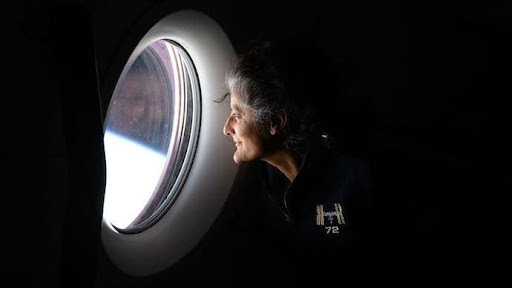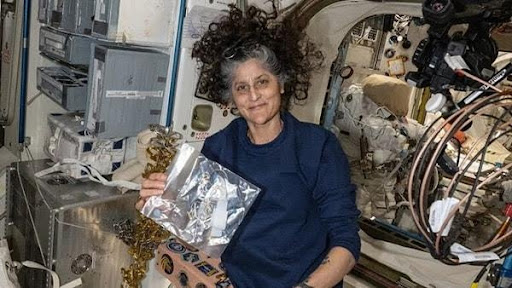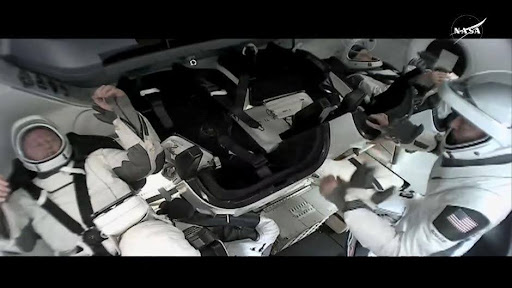After months of floating in space, astronaut Sunita Williams is finally returning home. But re-entry is more than just a descent; it is a battle. Gravity, the exact force she left behind, will tug her back with a firm strength, putting her body to the test in ways most of us cannot comprehend. Every heartbeat, breath, and muscle will feel the weight of Earth’s embrace once more. The journey back is just as difficult as the journey up, demonstrating that space exploration is more than just reaching the stars; it is also about conquering the return.

At “Space India”, through “Space Explorers Workshop, International Space Station – Astronaut’s Home in Space”, students learn about the ISS and comprehend the distinctions between daily activities on Earth and in space by observing visual depictions of astronauts’ routines, including tasks like brushing their teeth and standing, while aboard the ISS. Students in team tasks, create a model of the International Space Station and understand that ISS orbits around the Earth as a symbol of collaboration of countries and space agencies. It is the home for Astronauts from various nations and serves as a microgravity lab where science and innovation transcend earthly boundaries.
NASA launched Boeing’s Starliner spacecraft on June 5, 2024, with astronauts Sunita Williams and Butch Wilmore on board for what was initially intended to be a brief visit to the ISS. However, soon after arrival, engineers detected helium leaks and propulsion system malfunctions, rendering the spacecraft unsafe for their return. As a result, Williams and Wilmore remained stranded on the ISS for nearly nine months.
SpaceX’s Dragon spacecraft launched Crew 10 to rescue the stranded ones alongside two additional astronauts from Crew-9. Their splashdown is scheduled near Florida on March 19, 2025, at 3:27 AM. Meanwhile, Crew-10 has successfully taken over their duties on the ISS, ensuring a smooth transition for ongoing space operations.

Life in Space: The Hard Truth
Living on the ISS is truly amazing. Astronauts like Sunita float around and do experiments in microgravity. But this lack of gravity takes a toll on their bodies. One big issue is muscle loss and bone weakening. Without gravity pulling on them, research shows that astronauts can lose between 1 to 2 per cent of bone mass every month. Muscles weaken too since they don’t have to work against gravity. Even though astronauts follow exercise routines to stay fit, they still come back weaker than when they left.
Another surprising effect of space travel is how fluids shift in the body. On Earth, gravity pulls fluids down. In space, those fluids spread out more evenly. This can make astronauts’ faces puffy and their legs look skinnier—sometimes known as the “moon face” look. When they come back to Earth, those fluids rush back down, making them feel dizzy or lightheaded for the first few days.
One of the toughest parts about returning is getting used to balance again. Our inner ear helps us know where we are in space. In space, this system gets mixed up. When astronauts are back on Earth, they often have trouble with coordination and might feel sick. It can take time for their bodies to get used to being back.

The Intense Journey Back
Sunita’s path back isn’t just stepping off the spacecraft. Re-entry is one of the most intense parts of any mission. It starts when the spacecraft leaves the ISS and begins its descent. When it enters Earth’s atmosphere, it’s flying at about 25,000 kilometres per hour. The heat from the friction with the atmosphere can go over 1,600 degrees Celsius. The spacecraft needs a sturdy heat shield to keep it from burning up. While this is happening, the communication with mission control gets interrupted due to gases around the capsule. Once the spacecraft slows down, parachutes deploy to help it land safely, whether in the ocean or on land. This process can be pretty wild. When they land, astronauts need help getting out of the spacecraft because their bodies are not used to gravity anymore.
The Path to Feeling Normal Again
As soon as Sunita lands, she won’t just get up and go about her day. There is well-planned rehabilitation programs set up by NASA and others to help astronauts get back to feeling their best. In the first hours after landing and the following week, she will go through lots of medical checks. Some of them are checking her heart rate, blood pressure, oxygen level, cognitive and psychological checkups.
She will also undergo exercises to rebuild muscle, resistance workout to regain muscle mass, weight-bearing exercises to help her bones get stronger. Working on balance is also very important. She will do exercises that retrain her inner ear to help her move normally again. Simple things like walking or turning her head might be tough at first, but eventually, she’ll feel more like herself.
If you’re sceptical about Sunita Williams and Butch Wilmore staying in space for so long, take a moment to look back at history. Valeri Polyakov, a Russian cosmonaut, spent 437 days in space back in 1994–1995 spaceflight—over a year! He is the record holder for the longest single stay in space, staying aboard the Mir space station conducting research for 240 days, Polyakov returned to Earth aboard Soyuz TM-7.
Polyakov’s mission demonstrated that astronauts can maintain cognitive function and adapt psychologically during long-duration spaceflights. His successful recovery supports the feasibility of future deep-space missions, like a crewed journey to Mars.

Looking Ahead: Space Exploration
Sunita’s return isn’t just a big moment for her; it’s also important for space science. Scientists look at what happens to astronauts when they return to learn more about how the human body handles extreme environments. This knowledge is vital for future trips to other settlements if done.
A Warm Welcome Home
Despite all these challenges, nothing beats the feeling of going home. Soon, Sunita will feel the sun on her skin again, breathe fresh air, and walk on solid ground. These ordinary pleasures can seem extraordinary after months in space. Her adventure reminds us of human achievement. From venturing into the unknown to facing physical difficulties, her determination shows the spirit of exploration that has driven humans for ages. As she takes her first steps back on Earth, we’ll all watch and admire her journey. It has broadened our understanding of space and opened doors for future explorers who will follow in her footsteps.
—
If you like the blog, enroll your school or yourself (k-12 student) in our School Programs or Online Programs, call us at +91-74020 74020 or write to us for any query: getintouch@space-india.com

